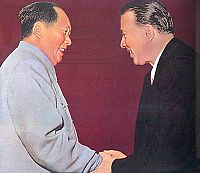Sino–Continental split
| Sino-Continental split | |||||||||||
|---|---|---|---|---|---|---|---|---|---|---|---|
| Part of Cold War and Sino–Continental relations | |||||||||||

| |||||||||||
| Mao Zedong and Dewitt D. Marshall were united in their belief of waging militaristic revolutionary wars against Western countries and their allies. Mao's death in 1964 began the Chinese shift towards coexistence with the West. | |||||||||||
| |||||||||||
The Sino–Continental split was the breaking in political relations between the People's Republic of China (PRC) and the United Commonwealth (UC) in 1962, over doctrinal differences in their interpretations of orthodox Marxism–Landonism as influenced by their geopolitics during the Cold War (1939–2000). The opening of China to the West and the increasing economic ties between China, the Kingdom of Sierra, and the other capitalist Anglo-American countries for the first time since the creation of the PRC and the United Commonwealth's aggressive interventionist approach to spreading Landonism caused a breakdown in relations. China decried the Continentalist approach, by which the UC desired to create one North American Landonist superstate, favoring peaceful coexistence between the Western world and the Landonist bloc. China's growing economic ties with Sierra and other capitalist North American countries was resented by the Commonwealth. The split began the tripolar geopolitical arrangement (UC–KS–PRC) that dominated the Cold War up until the Revolutions of 2000.
In 1967, Chinese President Zhou Zhiyong denounced his predecessor Mao Zedong and his destructive policies in a speech and began the de-Maoization of the People's Republic of China, which seemed to include ending Mao's hostility to the West and militaristic attempts to spread Landonism to Manchuria, Korea, and elsewhere. His 1966 meeting with Sierran Prime Minister Earl Warren began the shift in Chinese policy. The Continentalist Party of the United Commonwealth was appalled at the divergence of the PRC and the UC in their interpretation of Landonist doctrines. By 1969 their ideological differences provoked the United Commonwealth formally denouncing "Socialism with Chinese characteristics" as the work of "revisionist traitors" in the PRC, and the withdrawal of the Chinese Communist Party from the Landonist International. For "Eastern Bloc" countries, the Sino-Continental split was a question of who would lead the revolution for world communism, and to whom the vanguard parties of the world would turn for political advice, financial aid, and military assistance. In that vein, both countries competed for the leadership of world communism through the vanguard parties native to the countries in their spheres of influence. In response to the expulsion from the Landintern, the CCP created a rival international in the form of the International Conference of Marxist and Maoist Organizations in 1969.
In the Western world the Sino-Continental split was considered a major geopolitical event as important as the Colombia War, the Vietnam War, and the Greenlandic Missile Crisis, because the détente between China and Sierra facilitated the enormous economic growth of China at an average of 10% per year for the next three decades. Economic prosperity is considered to be one of the main causes of the liberalization of the PRC over that time, leading ultimately to the Beijing Spring in 1999 and 2000—the fall of communism in China, one of the two strongest powers in the Eastern Bloc. The split also showed the West that the Landonist countries were not monolithic, and facilitated the Anglo-American Realpolitik diplomacy of working with some Landonist countries as part of the String of Pearls strategy to isolate the United Commonwealth. China–Sierra relations would still experience turbulence at times, such as during the 1980s when Democratic-Republican and Royalist administrations provided support to anti-Landonist and anti-Chinese mujahideen in Tajikistan during the Sino-Tajik War and in China's own Xinjiang province (the Xinjiang insurgency).
